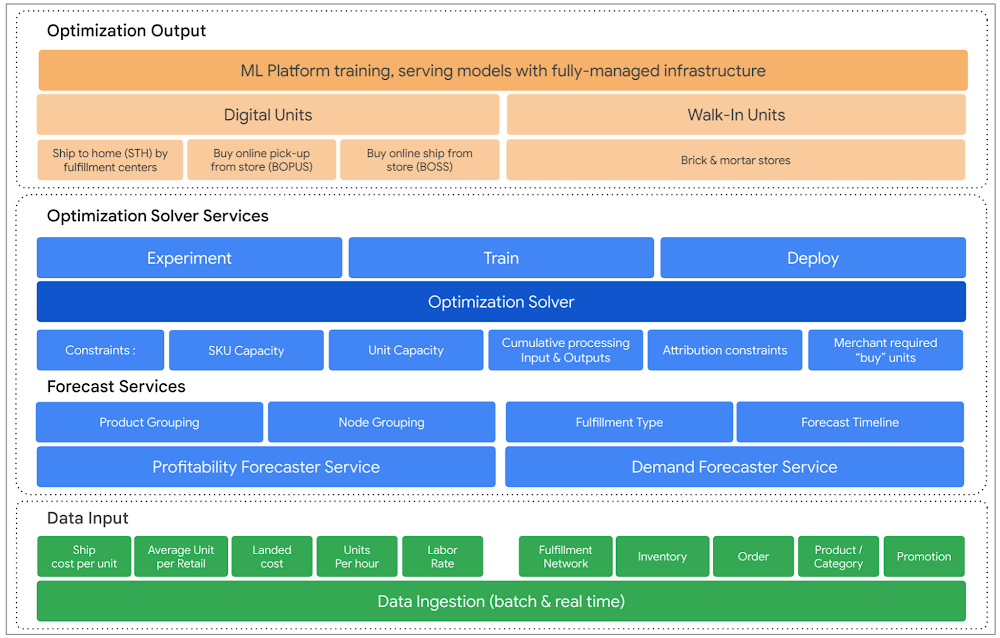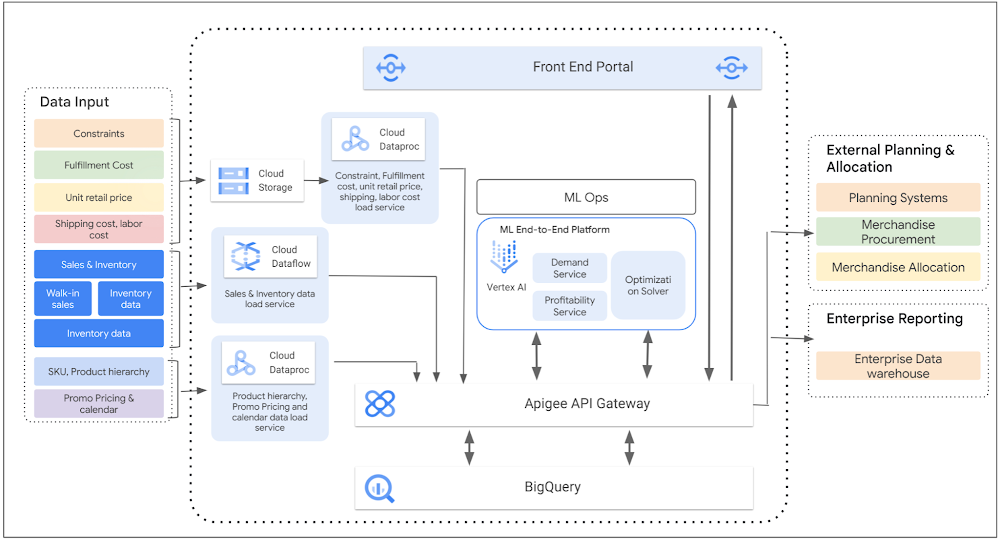During quarterly earnings calls, retail CxOs often talk about the impact to margins of extra shipping costs, increases in split shipments and monitoring inventory levels. Across the U.S. apparel sector, for example, earnings before interest and taxes dropped by over 30% due to accelerated demand of online business.
Today’s retailers are focused on improving profit margins by keeping their inventory low, offering fewer end-of-season markdowns and looking to pair anticipated demand to location by better optimizing allocations around their networks. Of course, shipping costs will continue to be challenging, but they should be less of a drag on margins if the retailer’s inventory is more optimally positioned. In other words, retailers need to forecast “relevant inventory” and also place that inventory at the “relevant node” if they want to maximize profitability.
Awash in inventory challenges
In fact, inventory remains one of retailers’ biggest and most complex challenges, especially post-pandemic and the shift from in-person to online shopping. Here’s just a sampling of the challenges retailers face:
-
Overstocking – Retailers look at average days to sell inventory, a.k.a. inventory turn, as one of their key performance indicators. Extensive analysis of retailers’ annual reports highlights the overstocking challenges retailers experience. Overstocking inventory causes cash flow problems, capacity constraints at fulfillment centers and stores, and pushes them to dilute the inventory through “markdowns” that impact profitability.
-
Elevated shipping costs – According to analysts, growth in a retailer’s online business can lead to a corresponding decline in profit margins. COVID-19 added a new wrinkle: the problem of inventory placement, which is not uncommon in the age of faster and more agile delivery times. If the shipper wants to avoid exorbitant inventory costs, the right inventory needs to be at the right location. Many retailers do not adequately pair anticipated demand to location and costs.
How cloud and data analytics can help
Today’s retailers are not only looking to optimize inventory but also how to optimally place the inventory at the right location. Increasingly, retailers are moving away from manually forecasting demand for seasonal merchandise based on past years’ actuals and their intuition. Instead, they’re turning to data and advanced analytics to transform their transactional data into insights and gather recommendations for future seasonal demand.
Functional reference architecture
As enumerated above, retailers’ challenges are twofold: to improve profit margins by forecasting the right demand and keeping inventory low, and pairing anticipated demand to location, keeping costs low by better optimizing allocations around its network. Google Cloud’s Retail consulting team has developed a functional reference architecture that suggests Google Cloud technologies, including AI/ML services, to help retailers forecast “relevant demand” and placing the inventory at the “relevant node.” This approach helps retailers improve profit margins by keeping inventory low and better optimizing allocations around their networks. Let’s take a closer look.
Demand forecasting service
The demand forecasting service predicts the guidance quantity for a defined period of the time into the future. The demand forecasted differs by retailers by:
-
the level (i.e., at SKU level or subclass level of the product hierarchy) and at the fulfillment level, i.e., Ship to home (STH) [common, web exclusive], buy online pickup from stores [BOPUS], buy online and ship from stores [BOSS] and walk-in.
-
the period, ranging from 9 to 18 months into the future.
Profitability forecasting service
The profitability forecasting service calculates the profitability of the SKUs and aggregates at the higher level of the product hierarchy (i.e. subclass). Profitability is calculated one of two ways:
-
From average unit retail (AUR), landed unit cost, cost of fulfillment and cost of shipping
-
Using a weighted calculation based on the number of units sold for the SKU. Calculated data is stored for every subclass, fulfillment type (STH common or web exclusive, BOPUS and walk-in) and the node (brick & mortar, satellite stores, fulfillment and distribution centers)
The functional reference architecture also considers capacity constraints, which include the in-bound units that can be processed in a given week, how many outbound units that can be processed given the inbound flow, and capacity. This is used to determine the maximum demand that can be allocated to a node for a given week
There’s also an optimization solver, whose goal is to maximize profitability by taking in the weekly demand predictions and the capacity constraints as inputs. The solver’s output is the guidance quantity at the product hierarchy level (as decided earlier), fulfillment node (be it the ecommerce fulfillment centers (EFC), retail distribution centers (RDC), satellite stores (SS), or brick and mortar stores) and for the fulfillment type (walk-in, BOPUS, STH) and for the decide future forecasting weeks.
Finally, merchants have the flexibility to override the guidance from the optimization solver based on business needs, priorities and other constraints.

Technical reference architecture
Working off the above functional reference architecture, here is a technical reference architecture, providing guidelines on the Google Cloud technologies that can be leveraged across different layers of the architecture. The basic building blocks of the architecture are as follows:
A data Integration and ingestion layer includes all data management and data integration-related Google Cloud services required to ingest and process data. Potential Google Cloud services include:
-
Dataflow, a unified stream and batch processing that’s serverless, fast and cost-effective. Dataflow is leveraged to transfer sales, inventory, product hierarchy and promo pricing and promo calendar event data into BigQuery.
-
Dataproc, a service for running Apache Spark and Apache Hadoop clusters. Dataproc is leveraged for all batch jobs.
-
Cloud Composer, a workflow orchestration service built upon Apache Airflow. Cloud Composer is leveraged to transfer any batch jobs that needs to be scheduled.
-
Apigee, Google Cloud’s native API management tool that provides abstraction to the backend services by fronting services with API proxies. All services, be it data loading, aggregated sales, profitability, demand and optimization solver, are treated as services leveraging Apigee to build, manage and secure APIs.
A Data Cloud or storage layer, provides a unified, open approach to store both the input and processed data. The Data Cloud enables data-driven transformation built for speed, scale and security with AI built in. Google Cloud services for this layer include:
-
Cloud Storage, a managed service for storing unstructured data. Store any amount of data and retrieve it as often and whenever you need it. Data related to capacity constraints, fulfillment, shipping and labor costs from external systems are stored in Cloud Storage before it’s processed and stored in BigQuery.
-
BigQuery, a serverless, highly scalable and cost-effective data warehouse for business agility and insights. BigQuery is leveraged to store the input data and processed data (that includes sales aggregated data, weekly demand and product profitability data).
-
If retailers are in Google Cloud, other database services including Cloud Spanner (a fully-managed relational database with unlimited scale and strong consistency and availability) to store product hierarchy, promo pricing data, and Cloud SQL (a fully managed database for MySQL, PostgreSQL and SQL Server) to store sales and inventory related transactional data.
Advanced AI/ML Services, the AI/ML layer on top of the data cloud, storage layer leveraged to build advanced AI/ML services includes demand forecasting, profitability forecasting and optimization solver service. Offerings in this layer include:
-
Vertex AI, a unified platform for training, hosting and managing ML models. Vertex AI is leveraged to build, deploy and scale ML models including demand, profitability forecasting and optimization solver faster with fully managed ML tools.
-
A visualization layer, or front-end platform, that retailers can build with cloud-native technologies and deploy into Google Cloud.

Considering the accelerated demand for digital, changes in customer buying patterns, and the associated costs in shipping and returns processing, it’s high time retailers start looking at leveraging their own data and the advanced data services tools and technology capabilities, including AI/ML services with Google Cloud, to forecast “relevant demand” and place inventory at the “relevant node” to maximize profitability. This approach helps retailers to improve profit margins by keeping inventory low, offering few end-of-season markdowns, and looking at a model to pair anticipated demand to that of location and costs by better optimizing allocations around its network. To learn more about how to implement this reference architecture, or to talk through your organization’s unique challenges, reach out to your Google Cloud sales representative.

